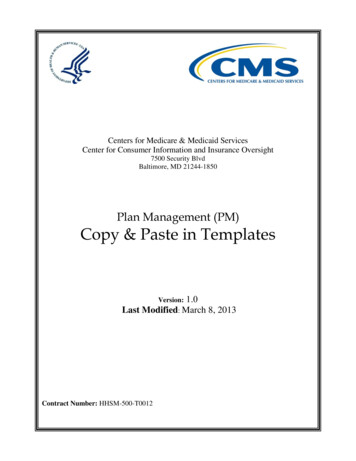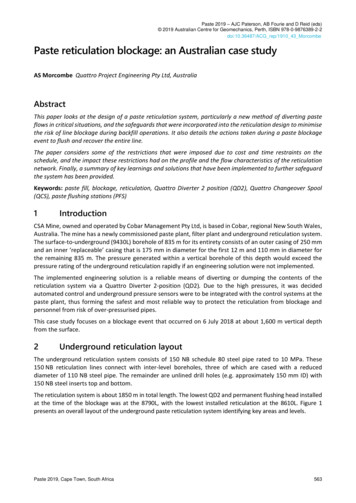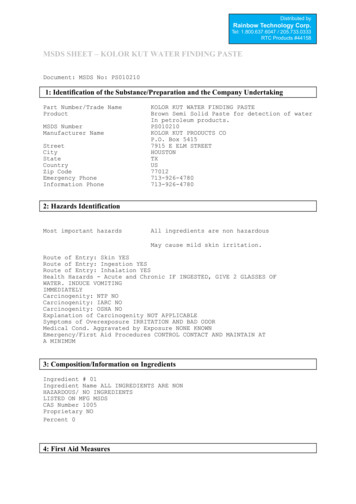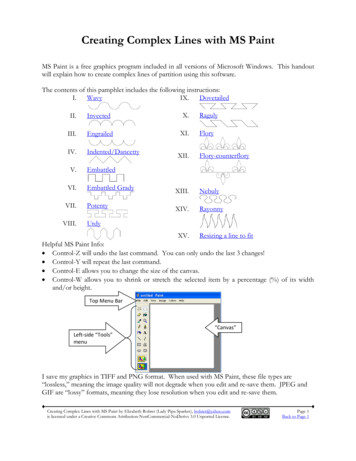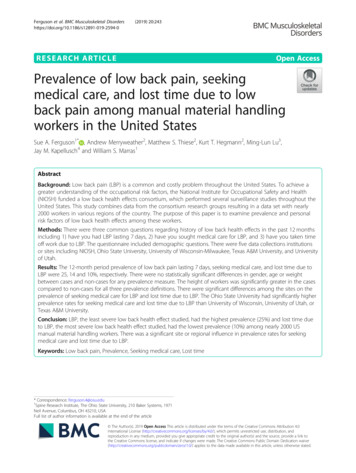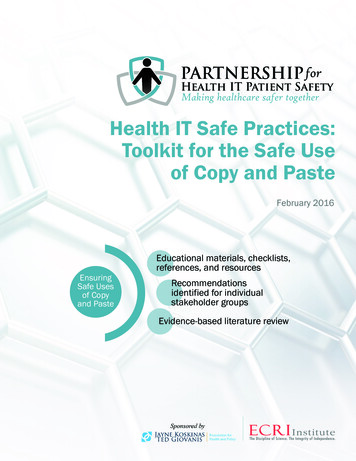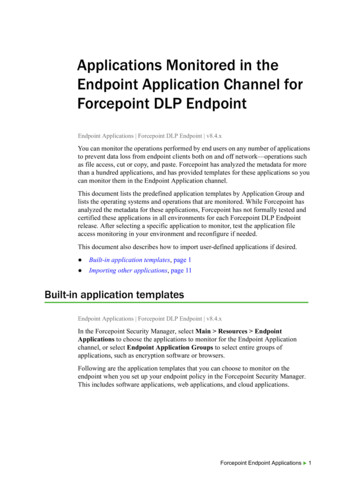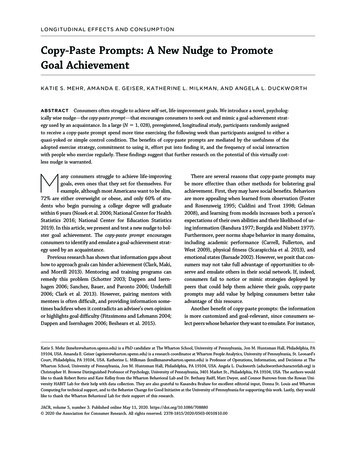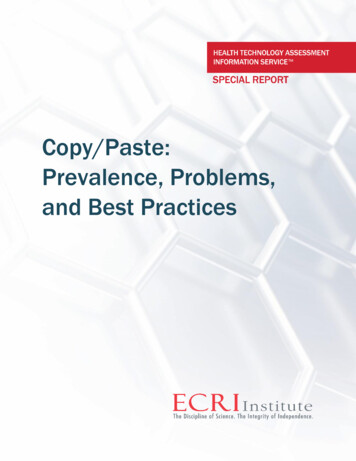
Transcription
Copy/Paste:Prevalence, Problems,and Best Practices
Copy/Paste: Prevalence, Problems, and Best PracticesContentsBackground . 2Methods . 2Results . 3What Is the Prevalence of Copy/Paste Use? . 3Self-reported Use . 3Chart-based Studies . 4Direct Observation . 5Problematic Consequences for Patients . 7Risks to Patient Safety . 7Association with Clinical Outcomes . 8Other Consequences . 8Problematic Consequences for the Medical Chart . 10Factors Contributing to a Challenging Environment for Medical Documentation . 11Recommendations . 13Author Responsibilities. 13Implications for EHR Design . 14Organizational Responsibilities . 17Commentary/Conclusion . 18References . 19Appendix A . 22Appendix B . 1TablesTable 1.Prevalence of Copy/Paste . 6Table 2.Study Definitions of Copy/Paste . 6Table 3.Study Categorization of Risk Associated with Copy/Pasted Material . 9Table 4.Common Themes Regarding Author Responsibilities . 13Table 5.Selected Proposed EHR Modifications to Address Problematic Aspects of Copy/Paste from theLiterature and Implementation Considerations. 15FiguresFigure 1Contextual Factors Contributing to Copy/Paste . 12 October 2015 ECRI Institute 1
Copy/Paste: Prevalence, Problems, and Best PracticesBackgroundThe copy/paste function in electronic health records (EHRs) allows users to easily duplicate information suchas text, images, and other data within or between documents. Many EHRs also support copy-forwardfunctionality, which allows authors to begin a new progress note by populating the text with the contents of aprior note, presumably to reflect the details of the new encounter. The increased use of EHRs, fueled in partby legislation such as the Health Information Technology for Economic and Clinical Health (HITECH) Act of2009, has highlighted both the unique strengths and challenges posed by electronic documentation ofpatient care, including the proper use of copy/paste and copy-forward functionality.Healthcare providers under time constraints use copy/paste to improve documentation efficiency andreproduce prior test results or medication lists (which might remain stable from visit to visit, but are germaneto the patient’s care) instead of laboriously retyping them. However, use of copy/paste may also contribute tolengthy and less-organized progress notes and propagation of outdated or inaccurate information in thepatient chart, with potential risks to patient safety. Increasingly, EHRs also allow measurement andlongitudinal tracking of clinical outcomes that can inform quality improvement initiatives—functions that arecompromised by inaccurate documentation. Recently, the U.S. Office of the Inspector General raised concernsthat inappropriate use of copy/paste could be contributing to reimbursement fraud. In response to theseconcerns, in 2014, the American Health Information Management Association released a position statement,titled Appropriate Use of the Copy and Paste Functionality in Electronic Health Records.1 Several otherorganizations, including the Federation of State Medical Boards, have also formally addressed this issue.Despite the importance of this topic, no published articles to date have systematically reviewed the evidenceregarding prevalence of and patient safety risks associated with copy/paste or copy-forward. In this review,we address the following four key questions:1) What is the prevalence of copy/paste and copy-forward use in the EHR?2) What evidence exists that copy/paste or copy-forward use is associated with adverse patient events?3) What characteristic problems are associated with copy/paste and copy-forward?4) What best practices or recommendations have been made to address proper use of copy/paste andcopy-forward? Although irresponsible use of copy/paste and cloned statements associated withreimbursement fraud are serious concerns, we considered this outside the scope of this project.MethodsWe conducted a systematic literature search of PubMed, MEDLINE, EMBASE, CINAHL, Journals@OVID,ScienceDirect, Scopus, PS Net, and the Agency for Healthcare Research and Quality Web Morbidity andMortality using a search strategy developed by a medical librarian. The search strategy (available uponrequest) included studies published from January 2010 to January 2015 and used a combination of medicalsubject headings and keywords. Bibliographies of identified studies were also reviewed for relevant citationsand additional articles. Gray literature was retrieved by searching the publications and websites of relevantvendors, professional organizations, private agencies, and government agencies. A doctoral-level analystreviewed abstracts to determine relevance. Specifically, studies were included if they addressed frequencyof copy/paste or copy-forward use, perception or attitudes among healthcare staff regarding these functions,copy/paste–associated patient safety or clinical outcomes, copy/paste–associated problems, lessonslearned, or interventions aimed at decreasing inappropriate use. Studies were excluded if they primarily October 2015 ECRI Institute 2
Copy/Paste: Prevalence, Problems, and Best Practicesaddressed use of copy/paste to address reimbursement fraud. We included 51 articles and tabulatedreported data regarding prevalence, patient safety outcomes, and recommendations and perceptionsregarding copy/paste or copy-forward.ResultsIn the first half of this paper, we summarize the evidence addressing key questions 1 and 2. We alsosummarize existing categories of risk severity used in the literature as well as healthcare providerperceptions of associated risks.In the second half of the paper, we address key questions 3 and 4 by offering a narrative summary ofpotentially problematic consequences to medical documentation, contextual factors likely contributing to anenvironment that promotes inappropriate copy/paste use, and recommendations/best practices gleanedfrom the literature. Specifically, we discuss recommendations from the literature addressed to individualauthors, professional organizations, and healthcare institutions. We also summarize suggestions from theliterature regarding potential EHR adaptations to address problematic copy/paste use. For simplicity,throughout the rest of the paper, we will use copy/paste to refer to copy/paste and copy-forwardfunctionality.What Is the Prevalence of Copy/Paste Use?Table 1 below provides an overall summary of prevalence estimates from included studies. We identified 13studies2-14 and 2 conference abstracts15,16 that evaluated the frequency of copy/paste use in 3 ways: by selfreport (survey studies of healthcare providers), retrospective review of patient charts, and direct observationof the note-writing process. Appendix A, Table 1 describes these studies in further detail. Overall, authorsreported high rates of copy/paste use, while frequency of copied material identified by chart reviews variedwidely, perhaps due to differing clinical contexts and varied definitions of copying (see Table 2). Notably, notall studies specified how copy/paste was defined.Self-reported UseWe identified three research studies published as full articles2-4 and one survey published only as aconference abstract.15 These studies surveyed healthcare providers’ use of copy/paste (see Table 1 forresults). Three large studies surveying medical students, residents, and attending physicians reported highrates of use across all training levels. O’Donnell4 surveyed 315 physicians and found that 90% of physiciansusing an EHR for inpatient documentation used copy/paste to write daily progress notes, and 78% identifiedthemselves as high-frequency users (using copy/paste almost always or most of the time). Eighty-onepercent of copy/paste users frequently copied notes authored by other physicians, and 72% copied notesfrom prior admissions. Heiman and colleagues similarly found high rates of use among NorthwesternUniversity (Chicago, IL, USA) medical students, with 66% reporting that they copied their own notes“frequently or nearly always.”2 Students were also asked how often they observed authors copying from adifferent provider’s note: 86% of students had witnessed this type of copying by residents, and 60% hadobserved it in an attending physician. Swary et al. surveyed 143 dermatology residents and found that 83%admitted to copy/pasting a prior author’s past medical history, social history, or family history withoutconfirming the information’s accuracy with the patient.3 Finally, in a smaller survey reported only in aconference abstract, 39 residents and 14 faculty at the University of Pittsburgh (PA, USA) were asked howoften they copy/pasted from a prior note in the outpatient clinic setting. Significantly lower rates ofcopy/paste use were reported (13% for residents, 7% for faculty).15 October 2015 ECRI Institute 3
Copy/Paste: Prevalence, Problems, and Best PracticesChart-based StudiesOutpatientWe identified nine studies published as full articles5,6,8-13,17 and one published only as a conferenceabstract.16 These studies assessed the frequency of copy/paste by performing retrospective chart reviews.Edwards et al. (2014) reviewed a random sample of 239 EHR notes from outpatient visits to anendocrinologist, cardiologist, or primary care physician for diabetes, coronary artery disease, or both.5Overall, 10.8% of notes contained copy/pasted material; frequency of copying varied significantly byspecialty: 19.5% of endocrinology notes contained copy/pasted material compared to 8.2% of primary carenotes and 1.9% of cardiology notes (p 0.01). No study definition of copying was provided.Two studies (Turchin et al. 2011 and Zhang et al. 2013) evaluated how often authors documented lifestylecounseling for patients with diabetes by copying from their own prior notes. Specifically, Turchin et al.explored how often attestations of lifestyle counseling addressing diet, exercise, and weight loss for adultpatients with diabetes (followed on average over 3.7 years) were copied.10 Copying was defined as use of asentence identical to a sentence in the previous note from the same provider for the same patient. Usingsoftware, 62,934 notes for 5,914 patients with diabetes followed for at least 2 years within a roughly 4.5year period were examined. Approximately 5% of lifestyle counseling statements were found to be duplicatestatements. To further assess whether this duplicate wording was the result of copying a prior note versusinserting a template statement, study authors compared how often a provider wrote duplicate statements forthe same patient compared to other patients. Duplicate statements occurred significantly more often for thesame patient than for multiple patients (3.0 versus 0.09, p 0.001), suggesting that providers were copyingfrom a patient’s prior note instead of inserting a template with standardized wording. A second study byZhang et al. assessed copying of lifestyle counseling statements in a similar group of patients with diabetesover a nine-year period; although this study primarily focused on evaluating whether evaluation andmanagement (E&M) codes were appropriately assigned, the study reported about 12% of lifestyle counselingstatements from primary care physicians appeared to be copied from a prior note.7InpatientIn a 2013 study, Thornton et al. retrospectively reviewed charts from 135 patients hospitalized at 1institution’s intensive care unit (ICU) for more than 72 hours to identify how often copying occurred in theassessment and plan (A/P) section of the chart.6 Using a program called CopyFind, the A/P section of eachnote was analyzed to identify matching phrases 4 words and 20 total characters. Notes were considered tocontain copying if the copied text composed 20% of the note’s text.Using these criteria, the study found that 82% of residents and 74% of attending physicians’ notes containedcopying. While resident A/Ps contained more copied material, the amount of copied material in each notewas slightly less for resident physicians than for attending physicians (55% versus 61%, p 0.01). Thedegree of copying was not associated with patient or provider characteristics such as age, race, length of ICUstay, insurance, or diagnosis.In a conference abstract, Chang et al. (2012) reported on a review of all inpatient documentation for 12general medicine patients and found that 229 of 299 progress notes contained “copy/paste events.” Morethan 60% of these events resulted from providers copying their own notes, while 32% occurred betweendifferent providers on the same service.16 October 2015 ECRI Institute 4
Copy/Paste: Prevalence, Problems, and Best PracticesVeterans Affairs StudiesThree studies (Hammond,12 Thielke,11 and Weir13) described the prevalence of copy/paste in VeteransAffairs (VA) hospital systems. Although these studies were published before our search dates, we includedthem because they were frequently cited in peer-reviewed research and gray literature.Hammond et al. (2003) performed a study within the VA health system to examine copying in all medicalprogress notes for 1,479 randomly selected patients over a 12-year period (1990–2002). A computerizedalgorithm identified all instances of 40 consecutive identical words occurring in 2 documents and foundthat 9% of all notes contained copied text, with 63% of these “copy events” due to human copying (asopposed to machine artifact).12Thielke et al. (2006)11 built on this work, focusing specifically on identifying copied physical examinations.The authors created and validated software to recognize the language describing examinations in the chartand identified 1,112 copied exams that occurred outside the context of a discharge summary. Roughly halfof these copied exams were physical exams (n 595), followed by podiatry exams (n 484) and mentalstatus exams (n 33). Overall, 25% of patient charts contained at least one copied exam; 11% of chartscontained more than one exam copied from another author. Notably, more than 80% of copying wasperformed by only a small fraction of authors (4.2%). Interestingly, podiatry exams were copied far moreoften (78.2%) than other commonly documented exams (9.7% mental status exam, 11.5% physical exam).On average, exams were copied 128 days after the original note (overall median 56 days, 2 days—inpatient,98 days—outpatient).A third VA study, by Weir et al. (2003), studied charts from 60 randomly selected patients admitted to a VAhospital for more than half a day. Nearly 20% of all inpatient notes (372 of 1,891) contained copiedmaterial, and physicians were responsible for 50% of copied notes.13 Nearly 90% of copying resulted fromauthors copying forward another note on which they made substantial edits reflecting the current encounter.When authors chose to begin a note by copying forward, they often chose to copy from their own prior note(nearly 60% of cases). However, in 29% of cases, authors chose to copy-forward another provider’s note.Only 1.6% (6 of 372) of notes were copied forward without any changes, and only 1 note (0.3%) wasapparently copied from another provider without modifications.OtherFinally, two smaller studies evaluated copy/pasting in particular contexts. Reinke et al. (2014) assessed arandom sample of 195 electronic surgical discharge summaries and found that 8% contained copy/pastedmaterial.9 The study noted that summaries containing copy/pasted material were significantly harder to readbut did not lower the note’s overall quality.9 Shah et al. (2013) investigated a sample of 388 radiologyrequests to assess how often clinical histories appearing within requests were “cloned” (copied from priorradiology requests instead of updated for each request).8 A clinical history was considered “cloned” orcopied if the identical history had appeared on radiology requisition forms for three consecutive days. Only7% of requests contained “cloned” histories, primarily originating from the neonatal ICU. Of the 27 clonedclinical histories, 11 (40%) were considered clinically inappropriate after review of the patient’s chart.Direct ObservationIn a small study, Mamykina et al. (2012) observed 11 residents writing 96 daily progress notes for a generalmedicine inpatient service.14 The study found that, on average, residents used the copy/paste function 0.8times per note. The SmartPaste function, which allows automatic insertion of specific current data fromelsewhere in the patient chart (such as labs and vital signs), was used 0.2 times per note on average. October 2015 ECRI Institute 5
Copy/Paste: Prevalence, Problems, and Best PracticesTable 1. Prevalence of Copy/PasteReferencePrevalence, ContextSelf-reported Use of Copy/PasteO’Donnell et al. (2008)490% of physicians (residents and attendings) using electronic notes reported usingcopy/paste to write daily inpatient progress notes. 78% used copy/paste almost always ormost of the time.81% of copy/paste users frequently copied notes from other physicians or prior admissions.Heiman et al. (2014)266% of Northwestern medical students reported copying their own notes frequently or nearlyalways.Swary et al. (2014)383% of dermatology residents reported using copy/paste to insert a prior author’s pastmedical history, family, or social history.Tilstra et al. (2014)1513% of residents and 7% of University of Pittsburgh Medical Center faculty copied from theirown prior notes to document outpatient clinic visits at a large academic centerChart-based StudiesEdwards et al. (2014)510.8% of outpatient primary care, cardiology, and endocrinology notes containedcopy/pasted material.Turchin et al. (2011)105% of diet counseling, 5.1% of exercise counseling, and 5.2% of weight-loss counselingdocumentation by primary care physicians for adult patients with diabetes were copied.Zhang et al. (2013)712.3% of primary care notes documenting lifestyle counseling were considered copied fromprior notes (by the same author).Thornton et al. (2013)682% of resident and 74% of attending notes in the intensive care unit contained copied text( 20% copied text from another document).Chang et al. (2012)1677% (229 of 299) inpatient medicine progress notes contained copied material.Hammond et al. (2003)129% of all notes (Veterans Affairs [VA] Health System) contained copied text, and 63% ofthese “copy events” were due to human copying.Thielke et al. (2006)1125% of patient charts in a Veterans Affairs (VA) health system contained at least 1 copiedexam, with the majority of copying performed by a relatively small fraction of authors. For11% of patients, charts contained an exam copied from another author.Weir et al. (2003)13Nearly 20% of inpatient notes for 60 randomly selected patients (at a VA hospital) werefound to contain copied material and 43 out of 60 patient charts contained at least 1 copiednote.Reinke et al. (2012)98% of electronic surgical discharge summaries were found contain copy/pasted material.Shah et al.(2013)87% of all radiology referrals over 3 days at a tertiary care children’s hospital containedcopied (“cloned”) clinical histories.ObservationalMamykina et al. (2012)14On average, residents were observed to use copy/paste 0.8 times per note when writinginpatient progress notes.Table 2. Study Definitions of Copy/PasteReferenceDefinitionO’Donnell et al. (2008)4Copy-forward functionality was considered copying. However, automatic insertion of vitalsigns and results was not classified as copying.Turchin et al. (2011)10A duplicated or copied documentation of lifestyle counseling was defined as “using asentence identical to the sentence used to document the same type of counseling in theprevious note by the same health care provider.”Zhang et al. (2013)72 notes from the same author containing identical sentences to describe lifestylecounseling. October 2015 ECRI Institute 6
Copy/Paste: Prevalence, Problems, and Best PracticesThornton et al. (2013)6Copying was defined as: matching phrases 4 words and 20 total characters.A progress note was considered to contain copying if it contained 20% copied text fromanother document.Thielke et al. (2006)11Hammond et al. (2003)12A copy-event was defined as 40 identical consecutive words between 2 documents.Weir et al. (2003)13Phrasing, content, or form 50% identical; assessors then categorized degree of copyingsubjectively.What Components Are Frequently Copied?While studies reported copy/paste use for nearly all aspects of the medical note (e.g., history of presentillness, physical exam, assessment, plan), only three studies with small sample sizes offered detailsregarding how often particular sections of the note were copied. Wrenn et al. (2013) subjectively examined asmall subset of 10 document pairs within a larger study and concluded that sections chosen for copyingappeared to vary based on type of note being written.18 For instance, the A/P was often copied fromadmission note to progress note. However, when writing a discharge summary, the history of present illnessand medication lists from admission were more likely to be copied.Chang et al. (2012) reported in a conference abstract the frequency of copy/paste in progress notes for 12patients hospitalized on a general medicine service.16 When providers from another medical service copiedmaterial from the daily progress note, the most copied elements included labs/studies (39.4%), insignificantportions of the plan (28.3%), past medical history (8.7%), and medications (6.3%). Also, Hammond et al.(2003) evaluated charts from the VA health system and reported that for a subset of 164 visits, the followingelements of the note were copied (in order of decreasing frequency): physical examination, history of presentillness, past medical history, assessment, problem list, review of systems, and chief complaint.12Problematic Consequences for PatientsRisks to Patient SafetyOverall, we identified no research studies assessing the prevalence of adverse patient outcomes resultingfrom copy/paste. However, we identified three case reports19-21 of adverse patient outcomes attributed tocopy/paste and two studies10,22 that captured the frequency of potential or perceived risks to patients.Hersh23 described a chemotherapy patient with a history of pulmonary embolus who was admitted fordiarrhea and dehydration. While the admission note A/P specified the patient should receive heparin forvenous thromboembolism prophylaxis, the medication was never ordered. After the patient was transferredto a different service, the A/P was copy/pasted for five days and approved by the attending physician, but noheparin was ever ordered. Shortly after discharge, the patient developed a pulmonary embolus and requiredreadmission.20,23In another case, a middle-aged man found to have atrial fibrillation and potential heart disease during anemergency room visit was discharged to follow-up with his primary care physician for a stress test. However,the primary care physician failed to diagnose cardiac disease and copy/pasted the A/P over 12 office visitsduring the next 2 years. The patient died from a heart attack, and the physician was successfully sued.19Finally, a third case involved an infant with fever, rash, and fussiness. The initial EHR note documented nohistory of tuberculosis (TB) exposure, despite the infant’s recent travel to a TB endemic country. Successiveoffice visits copy/pasted this negative exposure to TB for two weeks until the child received a diagnosis of TBmeningitis in the emergency room and left with significant residual deficits.21 October 2015 ECRI Institute 7
Copy/Paste: Prevalence, Problems, and Best PracticesA large analysis of VA medical records by Singh et al. (2013) found that copy/paste contributed to clinicaldiagnostic errors, some of which may have adversely affected patients.22 Singh et al. identified 2 “triggers”potentially suggesting diagnostic error: Trigger 1 was a primary care visit followed by an unplannedhospitalization within 14 days; trigger 2 was a primary care visit followed by at least 1 primary, emergencyroom, or urgent care visit within 14 days. A physician reviewed all “triggered” records to determine whetherdiagnostic error was present, based on information easily available to the practitioner at the time of the visit.If diagnostic error was considered to be present, a second, independent reviewer was asked to corroboratethe error. Of 212,165 visits over a 1-year span at 2 large urban medical centers, 190 diagnostic errors weredetected, corresponding to 20.9% of trigger 1 records and 5.4% of trigger 2 records. Failure to reviewprevious documentation contributed to 15.3% of errors. In 7.4% of cases, a practitioner had copy/pastedprior notes into the progress note; of these cases, copy/pasting mistakes contributed to 35.7% of errors.Unfortunately, the study provided no details regarding the nature of these copy/paste mistakes. Also, whilean overall summary of severity of risks associated with all diagnostic errors was provided, the study did notdescribe whether these specific copy/paste mistakes resulted in adverse patient outcomes.Association with Clinical OutcomesAlthough we identified no evidence that copy/pasting was associated with adverse clinical events, one studyfound that copy/pasted statements of lifestyle counseling were associated with less effective glucose controlfor patients with diabetes. Compared to copied statements of lifestyle counseling for diet, exercise, andweight loss, Turchin et al. found that noncopied or “distinct” statements were associated with a significantimprovement in HgbA1c among patients with diabetes: an increase of 1 monthly counseling episode wasassociated with a hazard ratio of 4.35 (p 0.001) for reaching HgbA1c target. In contrast, copied/duplicatecounseling or absent statements had no effect on glucose control.10Other ConsequencesOther reports of chart inaccuracies propagated by copy/paste were also detected.17,23-25 One physicianreported beginning a conversation with the family of a comatose patient by mistakenly stating that thepatient had only recently undergone surgery; a description of the patient as postoperative day two had beencopied daily in the progress notes for 5.5 weeks.18 In this case, this misinformation created mistrustbetween the family and physician, which could not be repaired.Inaccuracies propagated by copy/paste extended beyond the clinical realm. In one case, a patient reported afamily history of cancer. However, this was mistakenly listed under the patient’s past medical history andcopy/pasted into numerous notes by authors who failed to confirm the accuracy of this diagnosis with thepatient. Her insurance company subsequently accused her of withholding information about a preexistingcondition.26 In another case
using an EHR for inpatient documentation used copy/paste to write daily progress notes, and 78% identified themselves as high-frequency users (using copy/paste almost always or most of the time). Eighty-one percent of copy/paste users frequently copied notes authored by other physicians, and 72% copied notes from prior admissions.
